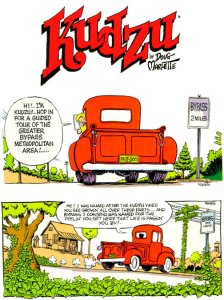| Look up Pueraria lobata , kudzu , or 葛 in Wiktionary, the free dictionary. |
Kudzu , a climbing, coiling, and trailing vine in the genus Pueraria, native to southern Japan and southeast China

Kudzu is a group of plants in the genus Pueraria, in the pea family Fabaceae, subfamily Faboideae. They are climbing, coiling, and trailing perennial vines native to much of eastern Asia, Southeast Asia, and some Pacific islands. The name is derived from the Japanese name for the plant East Asian arrowroot, クズ or 葛 (kuzu). Where these plants are naturalized, they can be invasive and are considered noxious weeds. The plant climbs over trees or shrubs and grows so rapidly that it kills them by heavy shading. The plant is edible, but often sprayed with herbicides.
Kudzu may also refer to:
- Kudzu (comic strip), Doug Marlette's daily comic strip created in May 1981
- Kudzu (game creature), a flower-like monster in the game SMASH Monsters
- Kudzu (newspaper), a newspaper published in Jackson, Mississippi starting in September 1968
- Kudzu (computer daemon), a Red Hat Linux hardware probing library
- Kudzu bug, a type of stinkbug and pest to crops - the Megacopta cribraria. Originally in India and China but recently infesting the south eastern United States.
- Kudzu.com, advertising service

Kudzu was a daily comic strip by Pulitzer Prize-winning editorial cartoonist Doug Marlette about rural Southerners. Distributed by Universal Press Syndicate, the strip ran from 1981 to 2007.

The Kudzu was a counterculture underground newspaper published in Jackson, Mississippi starting in September 1968. Promising "Subterranean News from the Heart of Ole Dixie" and offering a blend of hip culture and radical politics, it was founded by members of the Southern Student Organizing Committee (SSOC), a student activist group affiliated with SDS. Founding editors were Cassell Carpenter, David Doggett, and Everett Long, students at Millsaps College in Jackson. Despite harassment by police and city officials it survived until May 1972.
Kudzu is a hardware probing program which relies on a library of hardware device information. When the computer boots, kudzu detects changes in the running system's hardware configuration, if any, and activates the newly detected hardware. kudzu only runs at boot time, and then exits. There is no performance penalty during normal operation. kudzu detects and configures new and/or changed hardware on a system. When started, kudzu detects the current hardware, and checks it against a database stored in /etc/sysconfig/hwconf, if one exists. It then determines if any hardware has been added or removed from the system. If so, it gives the users the opportunity to configure any added hardware, and unconfigure any removed hardware. It then updates the database in /etc/sysconfig/hwconf. If no previous database exists, kudzu attempts to determine what devices have already been configured, by looking at /etc/modprobe.conf, /etc/sysconfig/network-scripts/, and /etc/X11/xorg.conf.
| This disambiguation page lists articles associated with the title Kudzu. If an internal link led you here, you may wish to change the link to point directly to the intended article. |










